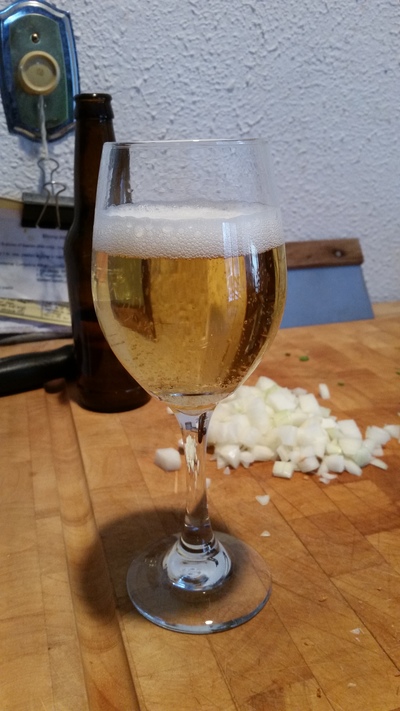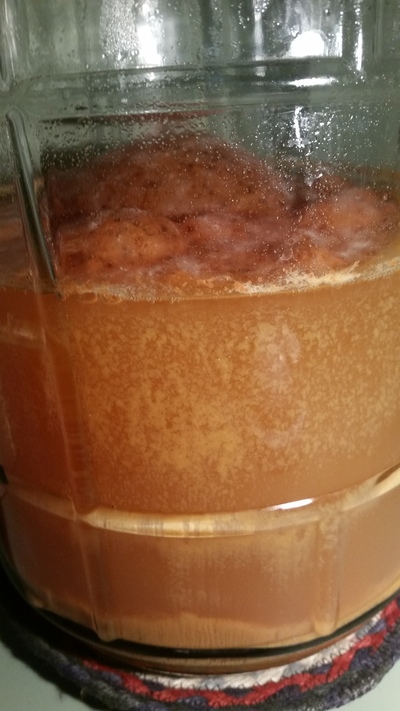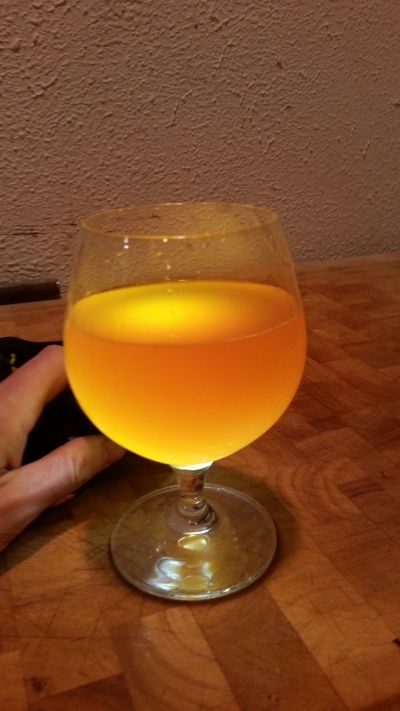It was an interesting year for apples. In my neighborhood, none of the wild apple trees produced any apples at all. Luckily at my friends A and H's house, they have 3 beautiful apple trees that had plenty! They were kind enough to let me come by and fill up several giant bags, which I brought home and plopped onto a blanket in the chilly spare room of our house.
The first batch (C5)
After carefully cleaning half the apples, they were then grinded using an old garbage disposal and squeezed through a big nut filter bag to fill up a 3-gallon carboy. I added some sulfites to kill off any bacteria and natural yeasts, waited a day or so, then added some cider yeast. A few weeks later, I bottled half of it and transferred the other half to a 1-gallon jug to continue fermenting. The first preliminary batch was pretty good, but had a lot of sediment because of my sloppy bottling process. When the gallon jug finished fermenting, I roughly calculated how much honey to add to bottles to carbonate the cider, and poured (again very roughly) some honey into each bottle before bottling. After a few weeks, I ended up with this beautiful, clean, refreshing cider:

I wish there was more of this, it was perfect. I was able to share it with a few friends. Luckily the process was straightforward - I basically just followed the rules by adding sulfites before-hand, so I am hopeful that this process will be reproducible.
The second batch (C6)
Time passed by quicker than I had control over, and eventually I was left with a pile of aged, softened apples in the spare room. I occasionally picked through them and tossed out any apples that had rotted. When I finally got around to it, there were still plenty of mediocre apples to experiment with. It seemed pretty hopeless, but I said screw it and got to work making a very bold batch of cider. Sort of a 'worst case scenario' cider. Without really rinsing or cleaning, I grinded and squeezed the apples, half-filling the 3-gallon carboy. Before long, some black spots formed on the surface followed by a thick gelatinous skin. (The second picture shows the pellicle after bottling):


I had expected there to be a lot of natural yeast on the skin to help the fermentation process, however it really struggled to ferment, but did so slowly. The skin that formed is apparently called a pellicle, which I believe occurs when making sour beers where bacteria is intentionally included during brewing. I haven't found much information about this occurring when people make hard cider, so we are now in unknown territory.
After a few weeks, worried that this bottle of bacterial disgustingness was going to infect my house and family (like some of my over-ambitious cheese-making experiments have done in the past) it was time to take the next step and bottle the stuff.
I'm not sure I had the guts to taste this stuff, but in my half-assed bottling technique, I have to suck on the siphon to start the process, and my siphoning skills are atrocious (but improving), and I ended up swallowing several big gulps of the cider, and didn't die! Bonus!
After a few days and still not dying, I cracked open a bottle and pretended like it was an ok thing to drink. Much to my surprise it tasted amazing! It has an otherworldly sweetness. Much more intense and sweeter tasting than regular cider. (The second photo is backlit):


Because the cider is sweet, I expect it has the potential to continue to ferment quite a bit and create bottle bombs. Also, the lack of yeast-based fermentation likely really opens the door for bad things to take over. But so far, the cider is really really tasty in my opinion, and has barely started to carbonate in the bottles. The best bet might be not to let it sit for too long, but who knows?
I would call this a successful experiment, but not something I would want to do again. A few weeks later I drank some kombucha (which is slightly fermented by yeast and bacteria) at a cafe, and it had a similar taste.
